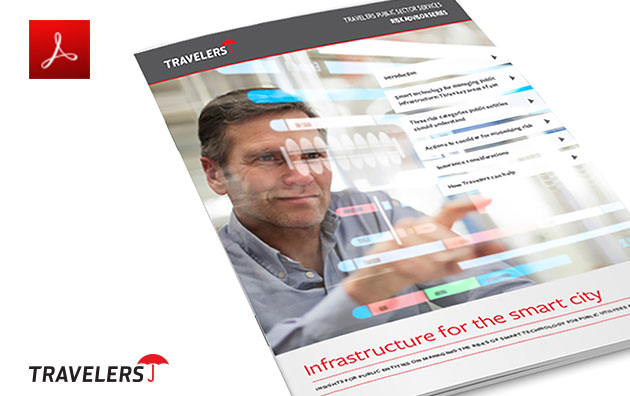How Smart Cities Prepare for Technology Infrastructure Risks


Municipalities and other public entities often look to emerging “smart” technologies to improve quality of life, as well as to improve their management of everything from local transportation systems to public safety. Often enabled by Internet of Things (IoT) devices, these smart systems can allow for improved decision-making, with powerful software processing large amounts of captured data.
Cities are also looking at smart technology to improve their management of local infrastructure. While this may offer convenience and improved productivity, cities must anticipate and plan for new risks, ranging from potential device malfunctions to cyberattacks. Following are three key areas where smart technology is increasingly used to manage infrastructure, and some of the potential risks for public entities to consider as they plan for the future.
- Smart water and sewer systems. Smart sensors can help municipalities conserve, manage and maintain their supplies and inform planning for the future. By embedding water sensors inside of reservoirs, dams and pipelines, city officials can more closely chart water supplies to determine when and how much they are storing. They can also monitor how much water is being delivered to homes and businesses, with embedded sensors detecting pipeline leaks and blockages and pinpointing where water is being lost.
- Smart electricity and power grids. Smart grid technology can help to monitor power lines and distribution to better manage electricity delivery. Power line sensors can notify utilities of outages in real time. Sensor-based systems can also help individuals manage their own power consumption.
- Smart public buildings. Connected sensors, big data management and advanced analytics can keep smart buildings operating efficiently. In addition to conserving energy through efficient operations, the technology can also regulate temperatures, control humidity, maintain systems and enhance security by restricting admission to private areas.
Smart technology comes with risks, such as a malfunctioning device or malicious cyberattack on critical infrastructure. Being aware of risks and taking actions to minimize them can help cities take advantage of the promise of technology while being prepared for potential problems.
Three smart infrastructure risk categories to consider:
- Cyber risk. Hackers and online criminals looking to steal sensitive data or disrupt public entities operations have an ever-increasing surface area as more smart sensors are put into service. A viral attack, an ineffective IT security policy or a security software failure could create an opening for a breach, and impact, including the financial and political results, can be disastrous. Public entities should protect their connected devices, network systems and electronic gateways, and ultimately both their stored data and smart operations, by adopting effective IT security measures.
- Property and collateral damage. If smart sensors should fail or if machine-to-machine communication operates incorrectly at the wrong time, it could lead to damaged municipal and/or private property. If a public entity’s smart technology causes property damage due to a defect or failure to function as intended, the public entity may be required to compensate victims for those damages and/or defend itself in litigation.
- Bodily injury. Defective sensors resulting in a malfunction could lead to injuries to municipal employees or the public. When planning and implementing smart technology, anticipate ways that things could go wrong to help protect a public entity’s employees, citizens and visitors.

Infrastructure for the Smart City
Explore several key ways in which cities and other public entities are using smart technology to manage public infrastructure.
Taking steps to minimize smart city technology risks for municipalities
Smart technology may present risks that many public entities have never encountered before. The more we learn about these risks, the more we understand how important it is for municipalities to mitigate those risks. Enhancing network and information security, practicing organizational and community readiness, and investigating tech-related insurance options are three areas where municipalities can help address smart tech risks.
- Network and information security. In an increasingly digital world, a network and information security incident can have far-reaching effects. It’s important to have a complete inventory of the critical assets in your organization so you can develop the appropriate controls to help mitigate losses. Conducting a risk assessment for each system that stores, processes or transmits sensitive information can help identify potential security gaps. Training employees on smart IT department policies and properly vetting any third-party vendors and cloud solutions can also help protect against a breach and help municipalities respond more nimbly in the event of an incident. There are a host of other issues to consider, including maintenance, monitoring and the implications of contract language.
- Organization and community readiness. In the event of an emergency, municipalities need a plan for operational continuity, including how to ensure rescue teams have the resources and tools they need to respond. Low-tech contingency plans and backup power systems can be invaluable in case of a citywide outage or a large-scale cyberattack. Remember that while smart technology can make decisions based on algorithms, it’s also critical to train employees on how equipment should act in the absence of smart technology, as well as how to implement work-arounds when a system or smart technology failure occurs.
- Insurance coverage for smart infrastructure. As this smart technology evolves, it’s difficult to predict all the ways cities could find themselves liable should systems fail to operate as expected. Information security insurance provides coverage for critical cyber risks. Property, auto liability and auto physical damage insurance can help protect against exposure to property and collateral damage. General liability insurance can help protect against exposure to bodily injury. Public entities should investigate their insurance options and discuss their unique needs with an agent or broker.
Smart tech brings both opportunity and risks to cities and other public entities. Taking steps to manage these risks, from conducting risk assessments to establishing low-tech contingency plans, can help mitigate exposure.



